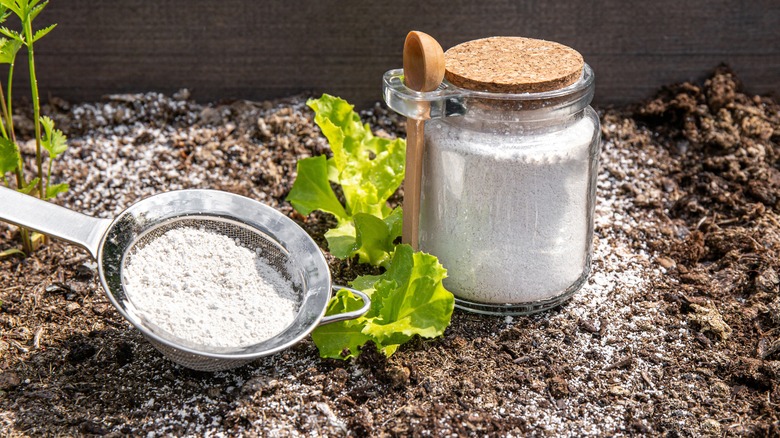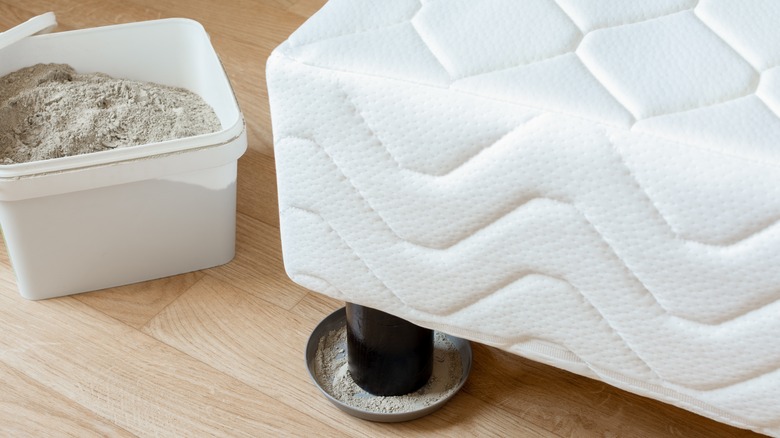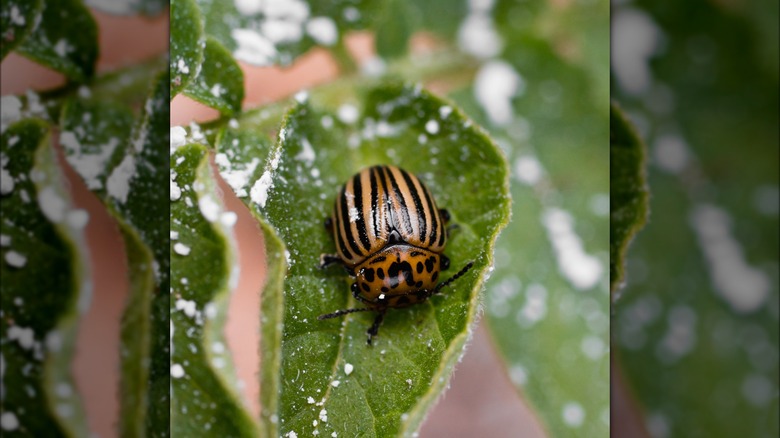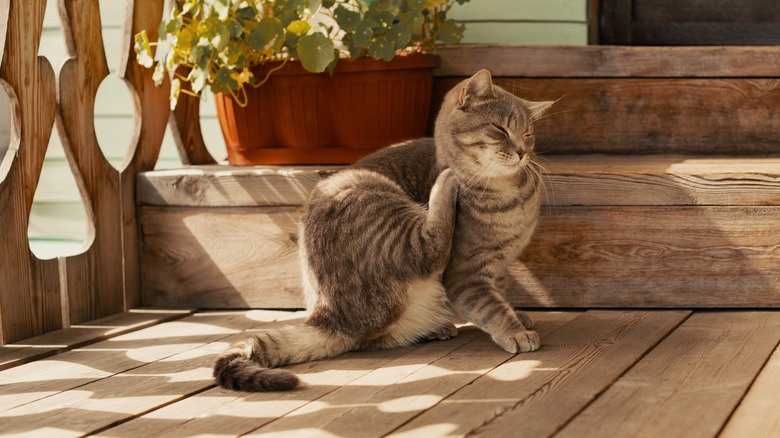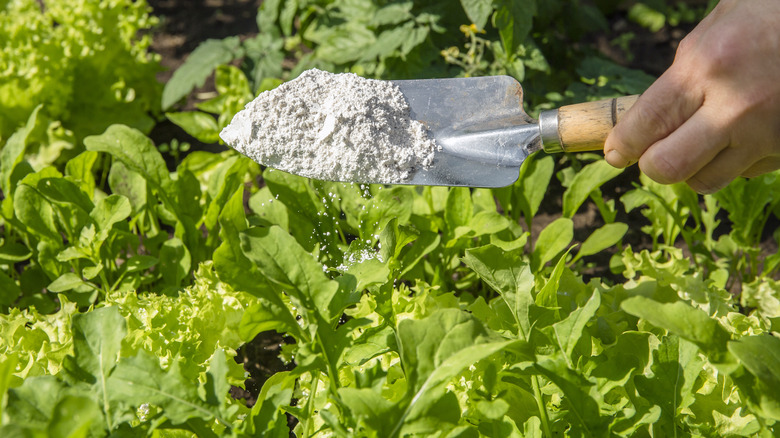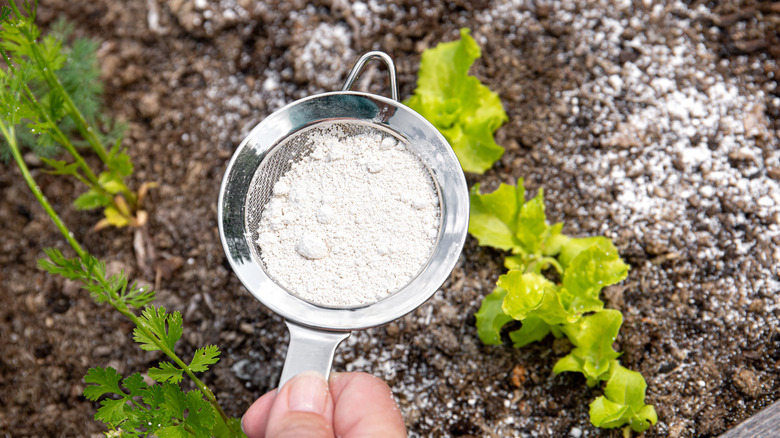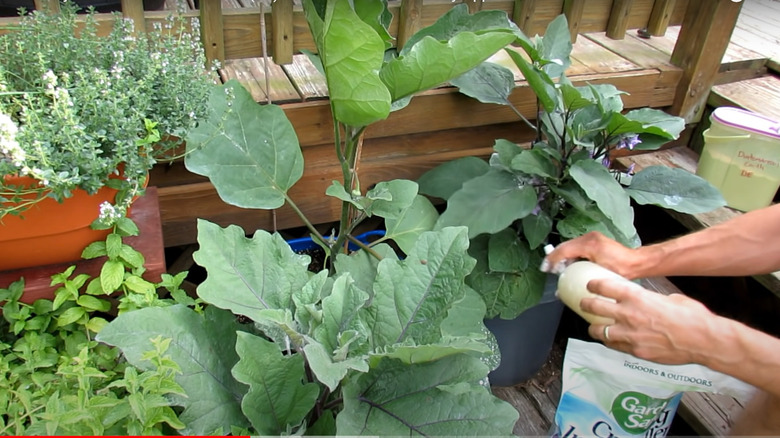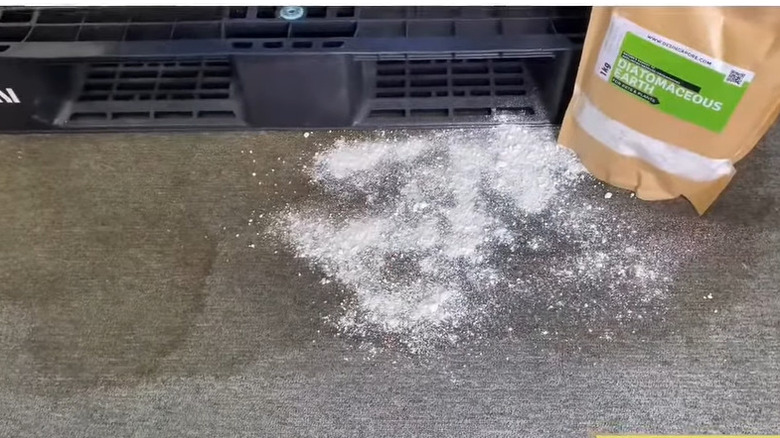Ways To Use Diatomaceous Earth Around Your Home And Garden
What's common to water filters, cosmetics, medicines, livestock feed, paints, and pesticides? They all often include diatomaceous earth (DE). If you've been following the discussions about environmental conservation, you'd have probably guessed that this substance is made from diatoms (just segment the name). Responsible for creating 20% to 30% of the earth's breathable air (per Diatoms of North America), diatoms are aquatic algae with silica-based cell membranes. When these organisms die and calcify, their deposits are mined and processed to create chalky, gray diatomaceous earth, or diatomite.
While its origin might feel a little dark and murky, it isn't toxic and falls on the US Food and Drug Administration's "Generally Recognized as Safe" (GRAS) list. As such, it's been approved as an agricultural anti-caking agent and insecticide. Pest control aside, DE holds utility across diverse applications, from improving the soil's nutrient profile and water retention to removing tough, greasy stains. However, this doesn't dispense with the need to take precautionary measures, as exposure to some dust formulations can cause skin, eyes, and nasal irritation. So, ensure you wear gloves, eye protection, and a respirator, and be fully clothed when using the product. This is especially important for products high in crystalline silicon dioxide—another natural form of diatomite—because they're smaller in size and have a higher risk of building up in the respiratory tract. So, stick to food-grade diatomaceous earth, as it contains between 0.5% and 2% crystalline silica and is relatively safer.
Repel insects meandering inside your home
Living up to its decades-old reputation as an effective insecticide, diatomaceous earth can naturally clear out your indoors of all creepy crawlies. Ants, roaches, carpet beetles, and even the highly-feared brown recluse spiders can't escape its clutches, provided it's dusted around all their harborage sites and trails. Using a teaspoon or a duster, spread diatomite in wide, thin layers across the doors, windowsills, underneath furniture, in wall crevices, and other hiding spots. Avoid sprinkling around swinging doors, vacuums, and air vents that may kick up the dust. Similarly, if you want to get rid of bed bugs, Tim Sherrer, a certified operator, recommends in a House Digest exclusive to sprinkle DE in your baseboards and the beds' cracks and crannies, as it will eventually kill them on exposure. You can use it on carpets, pet bedding, and cushioned furniture, but wipe them thoroughly before using them once the pests are banished.
You can also take care of unwanted bathroom visitors, such as the moisture-loving silverfish, by dusting their favorite hotspots, including corners and under sinks. The powder mustn't get wet, or it'll lose effectiveness. However, the pesky invaders won't die immediately, as the dust isn't poisonous and works by eroding and dehydrating their soft bodies over time. It effectively destroys ant colonies by allowing the ants to return with the dust. It has a lasting impact since the insects can't build any resistance to it.
Deter bugs from eying your houseplants
The bugs won't magically stop munching on your houseplants just because they're indoors. They will risk it if there's potential for food and shelter. While houseplants are less likely to have aphids sucking them dry, flies, fungal gnats, and mites aren't so kind. Luckily, diatomaceous earth easily takes care of these common household pests without synthetic chemicals. Simply spread it over the potting medium when it feels dry and wait for the pesky invaders to drop dead within five to seven days of application. Sprinkle a little extra around the pot to block crawling insects from reaching your plant. Another added advantage? It purges the larvae wriggling in the compost mix at your plant's base.
Avoid using the dust if the plant is due for a watering, as the powder hardens upon becoming wet, compromising its abrading and dehydrating effect. Diatomite works by leeching off the lipids from the bugs' exoskeletons, which happens no more if it's busy slurping the water in the soil. Besides, the tiny crystals' razor-sharp edges lose their sheen in solid form, making them less effective at cutting the pests' bodies. That being said, ensure DE doesn't get on the foliage, lest it dry out the leaves if left on for too long. Although higher dosages show better results, they can be harmful indoors, so look at the product's toxicity labels before using it. Otherwise, supplement it with natural products like neem oil.
Abate fleas pestering your pets
Not just your plants, but even your pet dogs and cats can sigh in relief if you judiciously use food-grade DE to rescue them from annoying fleas. But get it out of the cupboard only after you've caught the annoying pests with a flea comb. While you can dust your furry babies directly, it isn't recommended because overexposure can cause irritation and hurt their respiratory tract. It's also unwise for those with dry skin or asthma. Instead, add the powder to a big salt shaker or sieve and scatter it in areas where your pets sleep or play after you've cleaned it thoroughly. Also, pepper DE along the paths they tip-toe on to enter or exit your home. Leave it for about two weeks, vacuum the area afterward, and dispose of the contents outdoors. Dousing the carpets and pet bedding in diatomite should help, although it won't inhibit flea reproduction.
Diatomaceous earth's desiccant properties dehydrate the flea larvae before they mature, nipping the problem at its source. With your pets walking through or sitting on the elixir, the pests are taken care of as the contact corrodes their cuticles, sometimes in as little as four hours. Some fleas may also die from eating the powder because it ruptures their insides. You'll need to up your dosage if you plan to use it outdoors. Sprinkle only when the weather is dry. Multiple reapplications may be necessary in humid climates, as constantly wet diatomite is ineffective.
Amend the planting soil
While most gardeners wax eloquent about nitrogen, potassium, phosphorus, and other micronutrients, functional nutrients like silicon are often overlooked—for good reason. They're amply available in most soils. There's a catch, though, as not all silicon forms are water-soluble, making it harder for the plants to absorb them. Since diatomaceous earth is made of silicon dioxide, using it to amend the soil can bear fruit. To make it work, simply top up the substrate with a few inches of DE. Another alternative is to mix it in with compost before laying it down on the soil.
As a soil conditioner, DE can improve the nutritional profile of the soil, raising plant productivity. Not only silica, but it also adds trace elements like magnesium, calcium, and iron that play a critical role in furthering cell growth and chlorophyll production. It may even raise disease resistance for some shrubs. For instance, feeding cucumbers, pumpkins, and squash with silicon-based fertilizers has reduced their susceptibility to powdery mildew. Silicon is also known to advance the ability to bear droughts and metal toxicity. Applying DE to the substrate minimizes fertilizer and soil leaching, boosting plant health, as also found by Southern Cross University's research. This, in turn, enhances the plant's ability to withstand environmental stressors while optimizing fertilizer application. Even better is the data that it isn't toxic to aquatic animals, so its washing down (due to rainfall or otherwise) shouldn't be concerning, in contrast to chemical fertilizers.
Improve the soil's water retention
In addition to dust, local garden centers also sell diatomaceous earth as "aggregates", known for their pest control and moisture retention properties. At the same time, there are multiple sizes, medium and fine grades best-fit potting mixes, and soil mediums. Filling up around 10% to 20% of the topsoil with aggregates improves its porosity, raising its ability to uptake and retain water. This also affords better air circulation within the soil. For houseplants, however, raise the proportion to between 15% and 20%. Better water infiltration and lower fluctuations in moisture content will stimulate stronger root growth while reducing the irrigation frequency.
Being over 82% porous, diatomite aggregates can hold nutrients and water far exceeding their weight. This is handy in areas experiencing drought stress because they release water in times of shortage. They also work in poorly draining sandy soils. It also improves the permeability of compacted clay substrates. An Aksal et.al. study corroborates these facts, as it found that diatomite application optimizes water content, posting the highest gains in firm, dense soils. The added absorbency further eased the tilling of the soil. The best part? The impact is near-permanent, as the product doesn't degrade over time. Plus, you can use it for all flora, including flowering shrubs, trees, and turfgrass.
Keep your garden pest-free
Unlike pesticides that accumulate in and contaminate the soil and groundwater with time, diatomaceous earth is a natural, inexpensive way to repel major garden pests like millipedes, mites, aphids, earwigs, slugs, and snails. The default method is to evenly spread the inert dust all over the plant's stems and foliage using a flour sifter or a mesh strainer, in addition to creating circular barriers around their base to restrict the crawlies. Ensure the product is sprinkled thinly, or the insects will make a beeline for an alternate route. While this works great in smaller gardens, it can get too time- and labor-intensive in bigger landscapes. Applying it to the leaf's undersides can be cumbersome—even more so if it's windy. In such cases, liberally spritz diluted diatomite by mixing 1 to 2 tablespoons for every quart of water, as it attaches easily to the surface and works like a charm after it dries. Reapply when the leaves lose their white sheen or are exposed to dew and rain.
DE's prowess lies in discomforting the vermin walking through it, as its sharp edges cut through their exoskeletons while parching them dry of oils and water. However, it's only possible on soft bodies, as with slugs, but it doesn't work on hard-shelled Japanese beetles. You may want to rethink using diatomaceous earth because it's an indiscriminate killer, so don't use it around flowering plants to not harm the pollinators and beneficial insects.
Remove tough stains
Surprisingly, diatomaceous earth is as good at cleaning stubborn stains, as it is with pests, or so the anecdotal evidence goes. Irrespective of the area—hardwood, carpets, or floors—and the amount, the formulation will outdo all greasy stains. You can also use it as an all-purpose cleaner to scrub down grout, countertops, or tiles that tolerate a little abrasion. Using it is a breeze, too. Simply load an applicator with diatomite and cake it on the dirty spots. Leave it on for two hours, but extend the duration for bigger stains; don't wait longer than a day. Once the hour is up, scoop up the product and dispose of it.
That being said, switch the modus operandi a bit if you're cleaning carpeted floors. Flatten out dust clumps after they dry out and vacuum the area, provided you're using a non-filtered variant (it'll get clogged otherwise). Otherwise, stick to sweeping. If some residue remains, use the age-old soapy solution to wipe it clean; it should come off easier now that it has experienced some DE action. However, go light on the hardwood, as the abrasive granules may leave it scratched. Diatomaceous earth's absorbent properties are at work here, too. The highly porous material has an immense surface area to sop up all your oily messes (up to 1.1x times), putting paper towels to shame. Really, a little bit goes a long way, leaving you with spick and span flooring.
